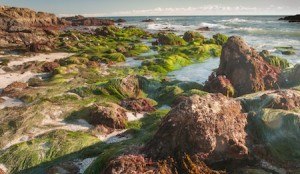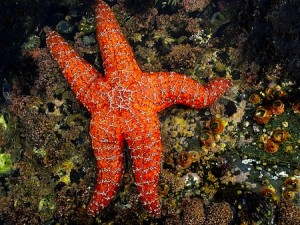
Usually submerged sea grass and boulders revealed by last week’s exceptionally low tide.
Laguna has experienced exceptional tidal swings in recent days called king tides, the highest winter tides when the sea rises to unusual levels and then dramatically retreats, revealing tidepools and sea creatures rarely seen.
Coming around a rocky platform north of Crescent Bay, for example, a friend and I discovered a usually submerged field of boulders smoothed by the sea. We hopped from rock to rock where human feet rarely tread, stopping here and there to gaze at the salt-water eddies hidden in between and the magical configurations of colorful sea creatures. Like children at play with no particular place to go, we easily lost track of time the more immersed with this space we became.
It wasn’t so much the rarity of the animals there — sea anemones, sea stars and urchins. We didn’t see anything terribly unusual. We saw things bigger than usual. They were colossal. Sea stars on steroids stretched two feet easy from tip to tip with arms at least eight inches long. Red spiny urchins, the oldest living tidepool creature at a lifespan of 200 years and rarer than the smaller purple variety, had spines at least five inches long. A neon green anemone expanded across a rock like a wavy jellyfish. We were “wow”-ing loudly and a lot, just like kids.
“You get to travel a little farther, a little bit deeper into an area that’s usually covered by water,” explained Jake Bonus, education coordinator for the Laguna Ocean Foundation. “It doesn’t necessarily mean you’re going to see anything different, per se, but you do have the chance because you’re going a little bit lower.”

An unusually large sea star in a rarely exposed tidepool.
My tidepooling pal, Glenn Murray, embodies the Laguna-lifetime experience – surfing, skateboarding, sailing, free-diving, fishing, cove and cave exploring. He knows every type of shell and which particular beach to find them, where his favorite octopus likes to dig its cave and where to see abalone. That was our mission at the moment. Finding an abalone. Sadly, even with an extreme negative tide, there was none in sight.
“Only the secret spots would be going off with abalone,” he said, referring to maybe 40 years ago. “Because of commercial fishermen taking mountains of them back in the ‘30s, ‘40s and ‘50s, they became extinct. The sea life I used to know just doesn’t exist anymore.”
The highest king tides, a colloquial term, occur when the sun and Earth’s moon are closest to the planet, and can climb into the seven-feet-above-sea-level range locally. That happens twice a year, once in the winter and once in the summer.
The King Tides Initiative, whose partners include the California Coastal Commission, began documenting high tides in 2010 to raise awareness about the impact of rising sea levels. “The sea level is rising by a few millimeters every year and has been for 13,000 years,” said Jake Bonus, education coordinator for the Laguna Ocean Foundation. “The fear is that the sea level will rise more rapidly because of global warming and we’ll probably see more flooding along low-lying coastal areas.”
The next lowest tides will occur again next week, starting on Wednesday, Jan. 23, with a minus tide of -1.3 at 1:51 p.m., almost as low as last weekend. While gravitational pull may reveal more of Laguna’s coastal habitat, for the last year nearly all of the town’s seven miles of coastline became a marine protected area and a posted no-take zone. Disturbing any sea creature in its native habitat by moving or removing it carries a stiff fine and, more importantly, can kill the animal. Enjoy them in their world but leave them alone.




